Setting up an Etsy store is quick and straightforward. The more challenging aspect is standing out on Etsy’s marketplace with millions of active sellers. This article shares more than 30 actionable tips for selling on Etsy, the value behind each, and how to get started.
Tips for Getting Started
Etsy doesn’t require a business license to sell on the site, but you are still required to comply with any licensing, permit, sales tax, and regulatory requirements that apply—particularly in the state where your online small business is based.
Here’s what you can do to get started selling on Etsy:
1. Determine if Etsy Is a Right Fit for Your Products
Knowing Etsy’s product policy will help protect you, your buyer, and the platform from legal issues, particularly regarding intellectual property. It also lets you understand the best way to categorize your products to make them more visible to potential buyers.
You can easily grab a copy of Etsy’s seller policy from the website. It covers the rights and obligations of Etsy sellers, including guidelines on what may be sold in each category.
Here’s a quick overview:
| What You Can Sell on Etsy | What You Can’t Sell on Etsy |
|---|---|
| Products you have created and have the rights to sell | Copyright material and handmade items that you didn’t make or design |
| Vintage items more than 20 years old | Weapons and explosives |
| Digital materials written or designed by you | Items that promote, support, or glorify hatred and violence |
| Products you created with a production partner | Items created from endangered or threatened animal species |
| Craft supplies | Alcohol, drugs, and tobacco products |
2. Identify Popular & Profitable Products to Sell on Etsy
The positioning of your product on Etsy depends not only on its popularity and demand but also on its profitability, ensuring it’s a viable option for you to sell.
As you can see from the graphs below, popular categories also top the bestselling categories.
In 2020, products related to home and living were the top sales category on Etsy, generating $3.2 billion in gross merchandise sales.
3. Understand Seller Fees
Etsy’s most common fees include a 20-cent listing fee, a 6.5% transaction fee per sale, and 3% plus a 25-cent payment processing fee per transaction. On top of these are pattern, conversion, and ad fees, which can get away from even the most veteran Etsy seller. Ensure your profit margins can sustain Etsy’s transaction, listing, payment processing, and ad fees.
To be successful on Etsy, sellers should always know how much they spend to use the platform to ensure they’re operating within their budget. Sellers should also know when and how to pay account fees to keep their store in good standing and minimize their overall costs.
Here are some tips to help lower your shop’s Etsy fees:
- Use the same currency for your product price and payment account to avoid conversion fees.
- If possible, find the most cost-effective shipping option for your products. Etsy charges a fixed percentage on your sales—including shipping.
- Remove slow-moving listings to avoid paying renewal listing fees for products that are not selling.
- Offer product variations instead of coming up with different products. For example, if you offer 100 different products, you need to create 100 product listings and incur $20 in listing fees. However, if you offer the same number of products (100 pieces) in 10 different styles, you only need to create 10 product listings and pay $2 in listing fees.
- Use product variations for bundles to save more on listing fees.
- Sync your Etsy shop to a free Square payments account to avoid Etsy’s Square Manual Transaction fee of 20 cents.
- Consider your target profit margin before opting in for Etsy ads.
Avoid changing the price of an item after a sale, misrepresenting the shipping location, or completing Etsy transactions outside of Etsy. These actions are considered attempts to evade fees and could lead to account suspension. Stay within the guidelines to ensure smooth operations.
4. Understand the Difference Between Copying & Inspiration
Contrary to popular belief, no rules specify what percentage of the original artwork must be changed to qualify for protection under the Fair Use Doctrine. There’s often a fine line between what’s copied and what’s inspired, and Etsy removes material subject to a complaint when given notice—making it vital to understand the difference before opening your Etsy store.
Etsy offers the following guidelines on intellectual property rights:
- Never use the name of an artist who inspired your work, as the artist may claim that your sales are a result of their brand.
- Avoid tagging your items with a specific luxury brand to describe your product’s quality.
- Using the brand name in the title, tags, and description of vintage products is allowed, but avoid guessing if you’re unsure.
- Always check for copyright when using someone else’s photos, even if the product on the image is generic.
- Avoid purchasing licensed images from stores with a poor reputation.
- If you plan on selling branded items, consider investing in license fees. This is less expensive than paying thousands of dollars in damages or legal fees or having your inventory impounded.
5. Choose the Right Shop Name for Your Store
Your shop name will be your brand. Remember, you only have seven seconds to make an excellent first impression, starting with your store name. A good name will help your store stand out from other shops and is memorable enough to type into the search bar.
Etsy allows you to use 20 characters for your shop name, which is required when setting up your store. While you’re free to change your Etsy store name down the road, you wouldn’t want customers to forget your brand because of multiple name changes.
Brainstorming and testing are the two main steps to developing the best store name. Start by making a list of options. Descriptive names like “Zen Handicrafts” is the most uncomplicated strategy. You can also try abstract ideas for a more creative and unique name. Try combining words or phrases like “Scentimental” to showcase a point of interest related to your product.
Use these questions to test your store name:
- What kind of feeling do you want your store name to convey?
- Did it evoke that same feeling when you mentioned your store name to friends and family?
- Is your store name easy to spell and read?
- Does the name look good on your business card?
- Does it have an alternative meaning in other languages?
- Have you tried to search for similar names on Google?
6. Research Successful Etsy Sellers
The next step is to explore existing Etsy shops. This is a great way to gain insights into successful store setups. You can either check out Etsy’s top sellers or search for shops that sell products in your niche. This research can provide valuable ideas for organizing and presenting your own store.
Etsy’s top sellers usually have a solid repeat customer base. Observe the following when you browse their Etsy shops:
- Products’ price ranges
- Shipping fees, particularly if they offer free shipping
- Implementation of tags, titles, and keywords
- Product photography
- Customer service reviews
- Social media channels (and if they are actively promoting on those channels)
- Usage of off-site ads for Etsy or ads for Etsy business
Doing your research will help you know what works and what doesn’t, and help you cut potential losses (of both time and money) when it comes to product marketing.
Etsy Tips for Setting up Your Shop
Setting up an Etsy shop is fully outlined in our step-by-step guide to selling on Etsy. After opening an account, you must set up your product listings, configure payment methods, and design your shop’s landing page.
Here are some Etsy tips to consider when setting up your shop:
7. Write an Impressive About Page
Etsy is more than just a marketplace―it’s also a platform for creatives to showcase their art. However, as a seller, you must show buyers the value of your creations to convince them to buy. This includes both your technical qualifications and achievements, plus your inspiration. Your “About” page should focus on the person behind the designs.

Take the time to show and tell shoppers the story behind your brand on your shop’s “About” page. (Source: Etsy)
Here are some guidelines for creating the ideal “About” page:
- Use a personal tone to connect with your reader easily.
- Talk about the inspiration behind your designs.
- Introduce any partners you work with to develop your products.
- Keep your paragraphs short.
- Include links to any publication that features you or your designs.
- Include links to your social media.
You have 5,000 characters to talk about your business, so go for a more personal approach when writing your story. Add inviting photos and videos to help shoppers visualize and connect with your store. Include a link to your blog, social media, or the landing page to opt-in to your email list.
8. Optimize Your Etsy Shop Profile
Your Etsy shop profile represents your overall brand and includes everything from your shop banner to your shop policies. A complete and well-thought-out shop profile with professional-looking photos and videos can quickly build trust with shoppers. So, before you open your Etsy store, you must put in as much effort to complete your shop profile as when you create your product listings.
Aside from your store’s “About” page, other sections of your shop’s profile also play a role in building your brand. Here are some additional tips for selling on Etsy to enhance your profile:
- Opt for a cover photo instead of a banner image. While it requires a bigger image (the ideal size is 3360 x 840 pixels), a cover photo is displayed on both desktop and mobile versions of your Etsy store.
- Shop banners don’t show up on mobile. They must be exactly 760 x 100 pixels and no larger than 2MB.
- Use a shop icon consistent with your business brand and logo.
- Research and use keywords for your shop title.
- Use brief, compelling copy for your shop announcement section to inform buyers of your promotions and discounts.
- Use the Shop Members section to introduce your team briefly.
Aside from reviewing your content before posting, you will also need to evaluate if the overall feel of your shop profile evokes the same emotions you want for your brand.
9. Keep Your Shop Policy Simple
Your shop policy sets the rules for transactions in your store. Customers often read this when they’re interested in a purchase and want to understand your payment and delivery methods. This is especially important for those buying personalized designs, as it informs them about their involvement in the design process and the expected timeline.
The key to a positive customer experience is keeping policies simple while being clear on the details. If you’re new to selling on Etsy, you can start with the basic shop policy, where you fill out a template that will toggle settings for options on returns and exchanges, payments, shipping, and additional information.
10. Add Multiple Payment Options
A recent study shows that 47% of shoppers have frequently abandoned a shopping cart because their preferred method wasn’t available. It’s important to consider that while online shopping is becoming the norm, some potential customers will still hesitate to share their credit card details online, no matter how secure your website is. You can avoid this lost opportunity easily by maximizing available payment options for your store.
Since Etsy requires store owners to use Etsy Payments, it enables you to offer various payment options without opening multiple merchant services accounts.
You can use Etsy Payments to accept:
- Credit cards
- Etsy Gift Cards and Etsy Credits
- PayPal
- Debit/bank cards
- Apple Pay
- Google Pay
You’ll want to make sure you also provide options for in-person customers. Square has partnered with Etsy to provide sellers with a quick and secure way to complete in-person payments from their phone or tablet and sync their shop inventory. Go to the Shop Manager page, choose Square from the Add Channel options, follow the prompts, and you’re good to go. You also get a Square card reader for free when you sign up.

Create a free Square account to accept payments for your Etsy shop in person. (Source: Etsy)
11. Capture Your Customers’ Email
Email marketing plays a significant role in online sales, with an average return on investment of $36 for every dollar spent. This is why every business owner must have a strategy for building their mailing list from the start.
However, this can prove tricky for Etsy sellers since adding the email addresses of people who bought from their store is against Etsy’s Terms of Use. The best option would be to create an opt-in form outside Etsy and advertise.
You can take several steps to build your mailing list while complying with Etsy’s seller policy:
- Create an account with an email service provider like Constant Contact or Mailchimp to create a landing page for your opt-in form.
- Include the link to your landing page on your Etsy shop’s profile, about page, listing descriptions, and thank you messages for recent buyers.
- Include the link on your shop banner, email signatures, and business cards.
Having this strategy in place from the start is essential because you can’t send this link through Etsy Conversations or to any of your old customers without violating Etsy’s Terms of Use (always double-check guidelines as they can change at any time).
Tips for Optimizing Product Listings
After setting up an Etsy shop, it’s crucial to optimize your product listings to ensure they rank well in the platform’s search results. In addition to using standard ecommerce SEO (search engine optimization) practices, these Etsy tips will ensure your products get the attention they deserve:
12. Visualize Your Etsy Shop Like a Brick-and-Mortar Store
Well-curated products in retail stores entice customers to buy more. You can achieve this effect with your customers when you plan your online store.
- Offer products that look like they belong together or complement each other
- Sell items at various price points to appeal to a wider shopper base, encourage multiple purchases, and attract repeat customers
- Offer products in different colors and materials
- Offer product bundles to appeal to gift-givers
13. Optimize Product Photos
High-quality product photos are key to driving sales. Listings with numerous, clear, and labeled images attract more customers by enabling them to better visualize the products. Additionally, photos are good for SEO—their alt-texts help in search indexing, boosting your store’s visibility in organic search rankings.
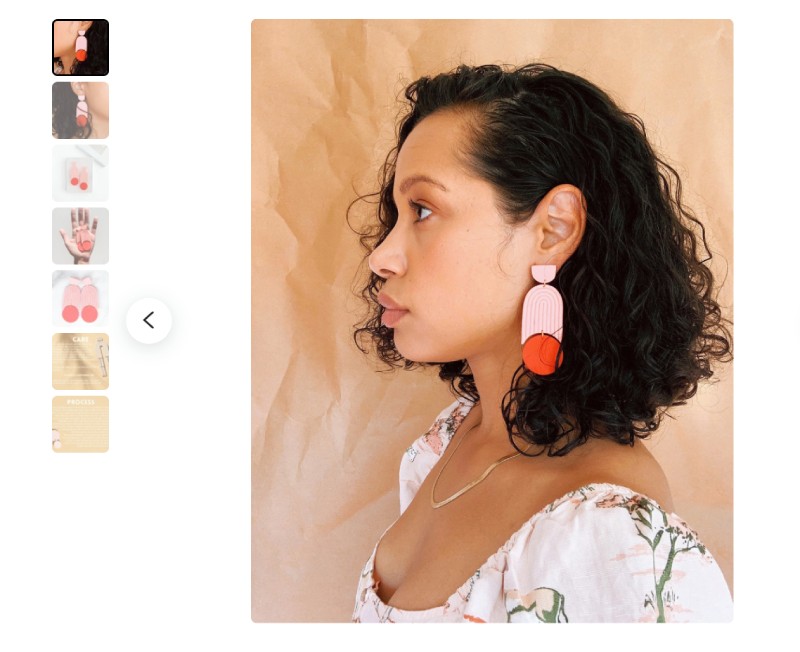
JessALittleShop’s product photos are shown in different ways, always with stellar lighting and photography.
There are several ways to optimize product photos:
- Add another object to give buyers a point of reference for your product’s size.
- Use high-quality photos for your product images that are well-lit and at least 1,000 pixels wide.
- Check for copyright when using stock photos.
- Use all 10 photos showing varying angles of your product, with the best one as your thumbnail.
- Curate your photos into navigable sections with a cohesive look and descriptions.
- Edit your photos by cropping extra white space and use professional editing software instead of social media app filters.
- Make sure to capture the item’s condition when photographing vintage products.
- Leverage Etsy’s augmented reality (AR) feature for listings in Paintings, Photography, and Prints categories. When browsing these items on the Etsy app, shoppers will notice a hexagonal icon on the top right of the listing photo. Tapping this icon activates a camera view, prompting the buyer to move their phone for enhanced imaging. Note that this feature is currently exclusive to the Etsy app for iPhone users.
- Avoid overly perfect, shadow-free photos against a pure white background, as they can give a mass-produced, generic appearance. Instead, opt for more natural, authentic-looking photos that highlight the handmade and unique qualities of your products.
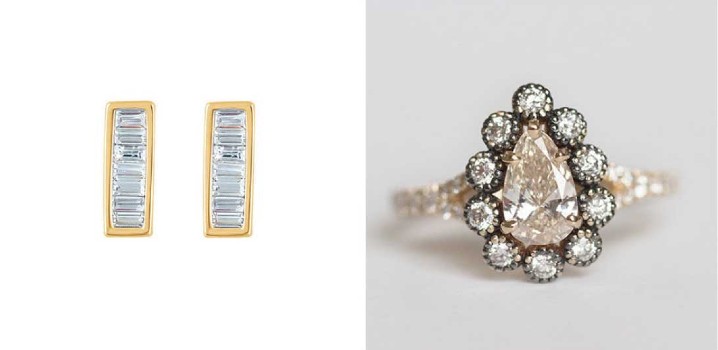
The photo on the left makes the jewelry look mass-produced, whereas the photo on the right offers a higher-end handmade look. (Source: Etsy Blog)
14. Add Relevant Categories & Attributes
Categories on Etsy help match your products with the right buyers, and choosing the most specific subcategory for your product can significantly enhance its search visibility.
Attributes, on the other hand, are detailed characteristics of your item—like color, use, occasion, earring location, collar style, or neckline. They are selected after you choose your item’s category and are crucial for accurately describing your listing, aiding buyers in understanding the look, feel, and use of the item.
The most basic strategy for identifying your product’s best category and attribute is to conduct test searches. List all possible types and features and enter the words in the search bar. Check the search results and confirm which keywords came up with products similar to yours. The left side of the page will give you all the relevant categories and subcategories, so feel free to explore refined results to find more matches for your product.
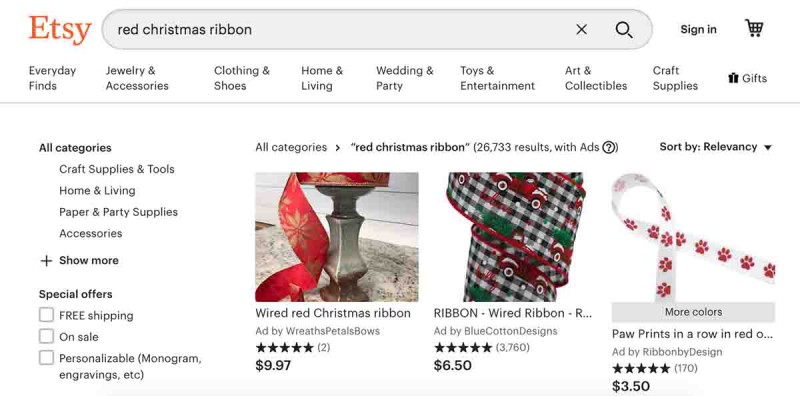
Check the search results for the keywords you target to see relevant categories.
15. Maximize Your Tags
Tags are words or short phrases, up to 20 characters, not separated by punctuations, which help describe your product. Etsy relies heavily on these tags to determine your product’s relevance to buyer searches. The search feature is designed to match keywords of listings with a shopper’s query and rank based on relevance. Given that Etsy is home to innovative, one-of-a-kind products, the use of tags, combined with categories and attributes, heavily influences search results.
Here are some tagging do’s and don’ts to maximize your listings:
| PROS | CONS |
|---|---|
| Use all 13 tags | Repeat tags, categories, and attributes |
| Use phrases | Use plural or misspelled words |
| Use tags similar to your title keywords | Use tags in multiple languages |
| Target long-tail keywords | Use irrelevant keywords |
A good rule of thumb is to start by identifying keywords that are unique to your products. Put yourself in your target customer’s shoes, breaking the keywords into phrases in different combinations.
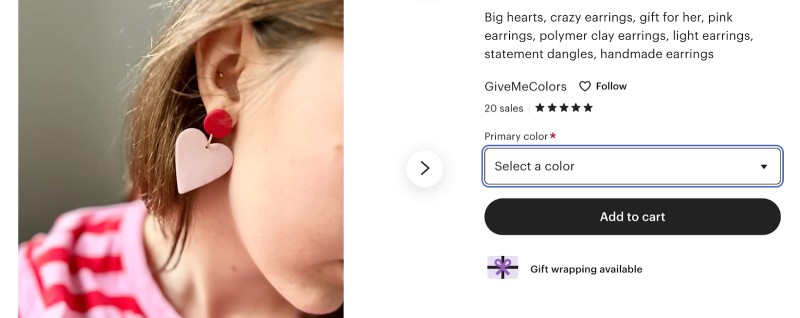
Notice how the product listing has perfectly matched tags for the product photo.
16. Write Effective Product Descriptions
The product description is integral to your listing. It details your product’s measurements, condition, color, age, and the different uses of the item. Besides the images, buyers rely on the information you include in this section to make their buying decisions, so you need to ensure that it’s descriptive and well-written.
Here are some ideas for writing product descriptions that sell:
- Use keywords similar to your tags and attributes
- Specify who the product is best for
- Mention unique materials or techniques that buyers should know
- Include the age or year for vintage product descriptions
- Mention the style and relevant solution-oriented phrases
- Specify dimensions both of the product and the size of the package when shipped
- Specify estimated production time and shipping
- Include information on how to purchase the product
- Name of your production partner, if any
It’s essential to keep the language of your product description short and simple. Use paragraph breaks when necessary to make it easy to understand. Repeat any promotions or discounts applied to the listing when available.
17. Adopt an Effective Product Pricing Strategy
Product pricing is one of the most important decisions a seller must make for their business. Determining a competitive price while keeping your business profitable requires developing a strategy that can only be learned over time. This can be particularly challenging to Etsy sellers as creative products, by nature, are almost always unique in that the cost of materials and labor are never the same.
Etsy’s seller handbook offers a helpful pricing worksheet and valuable ideas for developing a pricing strategy:
- Make sure your price covers the cost of materials and labor
- Make sure to account for overhead costs like shipping, marketing, ads, and promotions when computing for-profit goals
- Do research on competitor pricing
- Consider your target audience
- Consider the cost of shipping, which is based on the dimensional weight of the package
While researching competitor prices is helpful, it’s also important to note that having the lowest price is not always the best. Most veteran Etsy sellers will tell you that customers are willing to pay more for better-quality products.
Tips for Growing Etsy Sales
Creating repeat buyers is critical to ensure a steady stream and even growth of sales. An eRank survey showed that product quality (65.6%), free shipping (43.5%) and fast (29.9%) shipping, and seller responsiveness (20%) make customers want to buy again from an Etsy shop. More than 15% said giving out a coupon code would entice them to buy again from the same shop.
Etsy is home to nearly 90 million active buyers offering a vast opportunity for your shop’s success. To tap into this potential, it’s key to use retail marketing strategies specifically designed for growing online stores. Here are some growth tips for selling on Etsy:
18. Offer Competitive Shipping
Shipping cost is among the top considerations for online buyers. Etsy sellers quickly learn that most customers are attracted to free shipping, so much so that including this in your profile gives your store a significant SEO boost.
However, sellers will always have to deal with shipping fees unless their products are digital. So, while this strategy is not for everyone, there are ways to stay competitive:
- Set a minimum order quantity for free shipping.
- Include the average shipping cost in your upfront listing price.
- Incorporate free shipping based on the minimum, maximum, or average shipping distance.
- Find ways to save on packaging costs without sacrificing the quality and safety of the products.
- Etsy also offers a smart pricing tool to help you plan how to recover shipping costs.
19. Get Creative in Your Product Packaging
Another top Etsy tip is to personalize your packages to help stand out from larger brands. Small, thoughtful touches—like including a thank-you card or a small gift in orders—resonate very well with shoppers. These gestures can encourage customers to leave positive reviews for your Etsy shop.
Also, remember that Etsy is a marketplace for artisans, so packaging needs to be part of the creative process to strengthen brand recognition.
Lastly, creative product packaging is a potential marketing tool, with the unboxing videos people see on social media, especially Instagram, TikTok, and YouTube.
Learn more:
20. Become an Etsy Star Seller
Etsy sellers with a proven record of providing excellent customer service can be Star Sellers. As an Etsy Star Seller, you get a Star Seller badge to display and have a chance to be featured in Etsy’s marketing to buyers. Star Sellers generally get more sales and listing views than similar non-Star Sellers.

When you become a Star Seller, shop visitors see your badge right away—with all the top qualifications you have, like FlyingSkullSilver’s store.
Etsy sellers’ statuses are reviewed every first of each month, and the review period for Star Seller will look at the last three months of data before the review date.
To be eligible, your shop must meet certain criteria based on your data from the last three months. These requirements include:
- Message response rate: 95%+ of first messages in a thread are responded to within 24 hours.
- On-time shipping and tracking: 95%+ of orders ship on time with tracking or a shipping label purchased on Etsy
- Ratings average: Your average rating is 4.8 or higher.
- Minimum of five orders and $300 in sales during the three-month review period. (You must be on Etsy’s platform for 90 days after your first sale.)
21. Make Regular & Quick Store Updates
Regularly updating your Etsy store profile and product listings ensures that important information, such as pricing and contact details, is reliable and accurate. Unfortunately, busy business owners might not notice or even have the time to perform updates, which leaves them open to potential buyer misunderstandings and results in disputes.
Avoid this unnecessary risk by planning and regularly making quick updates to your store:
- Refresh your About section: Include any changes in staffing, improvements, and developments in your process.
- Update your shipping profile: This is used to quickly update multiple listings with similar shipping costs, including shipping origin, available destinations, services, and processing times.
- Review your store policy: Read through your shopping policy and update for any changes that may have developed since it was written.
- Upload new photos or videos when possible: Sharing changes and updates through images will help renew the interest of previous customers.
To stay on track, create a checklist and set up an alarm on your calendar for these updates.
Aside from designating a quick review once every few months, you can also schedule them on significant dates such as special events, holidays, and other peak seasons.
22. Utilize Etsy Shop’s Announcement Section
Your Etsy shop announcement is at the top of your shop under the main header. It actually is counted toward your SEO, so it should contain shop-related keywords because the first few lines are searchable in Google.
Keep your announcement bar always updated. Your Etsy shop announcement is a way to communicate the main points to your customers quickly and a good opportunity to advertise your offerings.
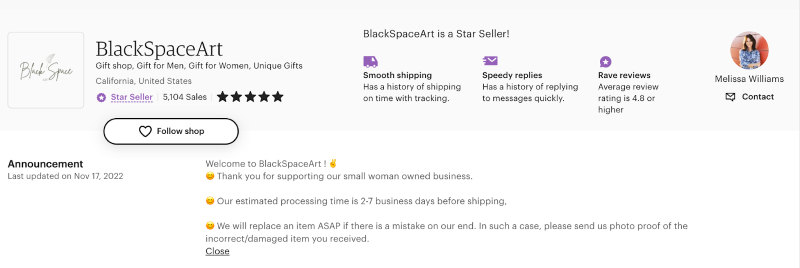
BlackSpaceArt’s announcement is short and straightforward—setting shipping expectations and laying out replacement and refund policies.
Some ways to use your announcement section are to notify of big changes in the shop, such as a change to postal fees, product restocks, holiday schedule, and more.
23. Entice Customers With Etsy Updates
The Etsy Updates feed shares shop notifications to people who have followed your shop or favorited your items. They see the Updates feed by clicking the bell icon in the Etsy navigation bar on Etsy.com or in the Etsy app. Although Etsy Updates is not a new feature, it has been recently enhanced and improved for sellers.
You can use this feature to amplify your marketing efforts. The Updates feed notifies customers every time you:
- Run a sale
- Send a coupon
- Add new items
- Restock items
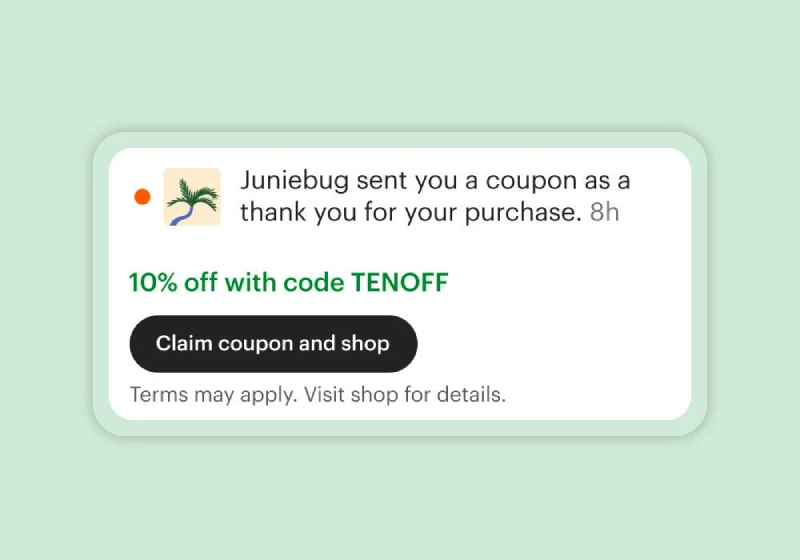
Etsy can automatically send a coupon to your customers 24 hours after you mark their orders as complete to encourage a repeat visit. (Source: Etsy)
24. Get Involved With Video
Etsy’s Explore feature lets sellers upload videos through the Etsy Seller app. Explore videos can be anywhere from two seconds to three minutes long and include sound. Etsy wants sellers to use videos to connect with shoppers and tell their shops’ stories.
Use our guide to creating product videos at home to shoot a sales-boosting video for Etsy.
Here are some ideas for videos you can make:
- Product Demo and Showcase: Show off your product’s details. A product demo, which shows your product in action, can show how a buyer can use it.
- Seller Creative Process: Give shoppers a behind-the-scenes look at how you create or develop products.
- Fulfilling Orders: Let your buyers take a peek behind the scenes of you packing sold items and shipping them.
- How-to Tutorial: A project inspiration reel or instructions on how you make your crafts can help them learn how to do it themselves.
25. Explore Multichannel Sales
Special events and holidays are an excellent opportunity to maximize sales by expanding into new markets and categories. These periods are ideal for tapping into the demand for unique gifts, offering a way to quickly increase revenue. Additionally, it’s a great time to attract wholesale and international buyers, providing a substantial uplift to your business.
Significant challenges of multichannel sales include maintaining inventory records and accepting payments. If you need to set up an in-person sales channel when attending local events like fairs and trade shows, Etsy has a partnership with Square so you can automatically sync your store’s inventory while accepting payments through the mobile POS app.
26. Engage Your Customers
Engaging with customers both before and after sales is a highly effective marketing strategy. Activities like building a mailing list, developing a customer service process, and interacting on social media offer numerous ways—both free and paid—to enhance sales by fostering relationships with your audience.
The first step in a customer engagement strategy is to know your audience and where to find them (creating a shopper profile is a good starting point). Once you’ve succeeded in connecting with your target customers, these tips will help you maintain a solid relationship with them:
- Send your newsletter at regular intervals
- Develop a cart abandonment recovery email strategy
- Advertise your blog, website, and social media in your “About Me” section
- Interact with your followers on social media
- Use Etsy’s saved reply tool to save pre-written customer service messages
- Set up a “thank you” message under Settings > Info & Appearance tab that will be sent to each customer post-purchase
While paid marketing strategies are highly effective, the steps above are easy and actionable selling on Etsy tips, even for new sellers.
27. Identify Your Top Traffic Sources
Once you’ve spent some time selling on Etsy, you need to develop a way to evaluate how your store is performing. These metrics will guide you in adjusting your strategy to improve your sales. Analyzing your top traffic sources will let you know where your potential buyers are coming from and identify which of your marketing and advertising efforts are paying off.
Here’s how to do it:
- Go to Your Shop > Shop Stats
- Look at your Traffic Sources
- Note your list of referrer websites (websites that have successfully redirected customers to your store)
- Get regular reports and compare before and after stats
- Join Etsy’s Shop Dashboard prototype team for tools to interpret your old and new traffic reports
Some marketing and ad strategies cost money that can eat into your bottom line. You’ll be able to plan your budget wisely when you understand which strategy works for you.
28. Improve Low-performing Listings
Low-performing products don’t stand out, which is why they’re easy to overlook. They don’t get featured regularly, costing Etsy sellers renewal listing fees every four months. This can quickly add up if your store has hundreds of listings. However, these low performers are often easy to improve.
Etsy’s Shop Stats feature is the quickest way to uncover low-performing listings:
- Look at the traffic you’ve received in the last 30 days and scroll down to Pages Viewed to know which of your shop’s pages are getting the most and the least traffic.
- Click on the arrows under Pages Viewed until you get to listings that register a minimal amount of traffic.
- Click on a listing to open a Listing Page View that offers a breakdown of traffic for that specific listing.
Once you’ve identified your low performers, evaluate the page and find areas that may need improvement. You might have to update keywords, improve images, change categories, or rewrite your description to increase page views.
29. Plan Your Product Releases
Etsy is an ideal place for shoppers seeking gifts for special occasions. Knowing specific holidays, events, and trends throughout the year can help you plan your product launches accordingly.
Aside from the most celebrated holidays (like Valentine’s Day, Halloween, and Christmas), other events and seasonal trends also drive consumer interest and can boost sales. Some key occasions to consider when planning your product releases are:
|
|
Etsy Tips for Marketing Your Shop During Holiday Season
Shoppers spend billions on Etsy during the holiday season (from October to December). Aside from this potential sales increase, you can extend your business growth easily past the holiday season.
Here are some Etsy tips on how to make sure you maximize the holiday opportunities:
30. Look at Holiday Trends
Etsy publishes a holiday trend insight report each season. It is a good way to know the market’s demands and plan your product releases. Consider how to add some popular items or your version of them to your inventory.
31. Participate in Etsy-wide Sale Events
Participating in Etsy-wide sales events during the busiest season can help attract motivated holiday shoppers visiting Etsy. During last year’s Etsy Cyber event, participating listings sold at a higher rate than those not on sale. Keep yourself updated on how to take part in Etsy’s sales events.
To reach as many potential customers as possible, share your shop’s sale details on social media and other marketing channels, such as your blog or newsletter.
32. Start Early
Since Etsy is known for personalized products, stock up early to allow time for customization requests. Launch your holiday products well before the season and maintain inventory through Cyber Week and into December. This strategy ensures you capture early birds, peak season shoppers, and last-minute buyers alike.
Additionally, an early start allows you to adjust your inventory and marketing strategies based on initial customer feedback and trends.
33. Cater to Last-minute Shoppers
For last-minute shoppers, offer digital downloads for printables, fast turnaround times, ready-to-ship items, and expedited shipping options. You can also highlight gift cards or e-gift options, which are perfect for those making very last-minute purchases. Emphasize these options in your shop’s announcements and marketing materials to attract customers who need quick solutions.
34. Get a Head Start for Next Year
To keep your shop’s momentum going after the holiday rush, stay ahead by identifying emerging trends for the early part of the new year. Focus on areas like wellness and fitness, which often gain traction, and cater to self-gifting buyers who shift their attention to these themes in January. This proactive approach helps you align your offerings with customer interests right from the year’s start.
Bottom Line
In 2022, Etsy hit $13.3 billion in gross merchandise sales, and has the potential to reach even more shoppers this year. With the right Etsy tips, you can leverage this unique marketplace to enhance visibility and grow your business.
Selling on Etsy is an excellent way for entrepreneurs to find a sizable market without spending a lot of upfront capital, and it continues to grow as one of the most popular retail platforms for small business owners starting a retail business. So, whether you’re a beginner or a longtime seller, follow our tips for selling on Etsy to boost sales and strengthen your brand.
